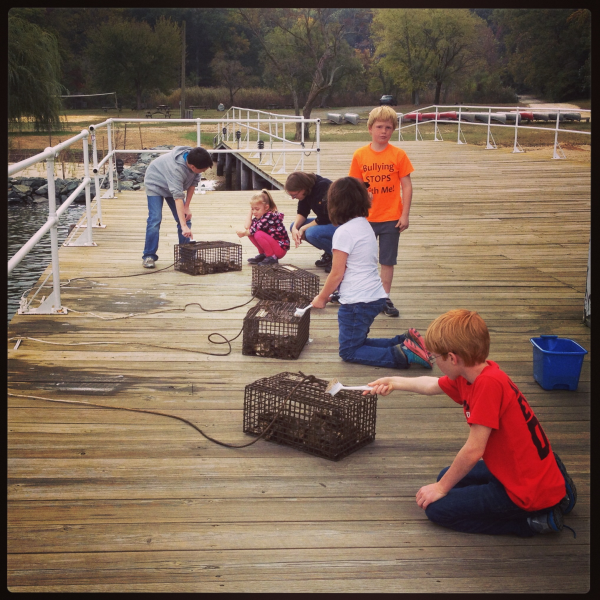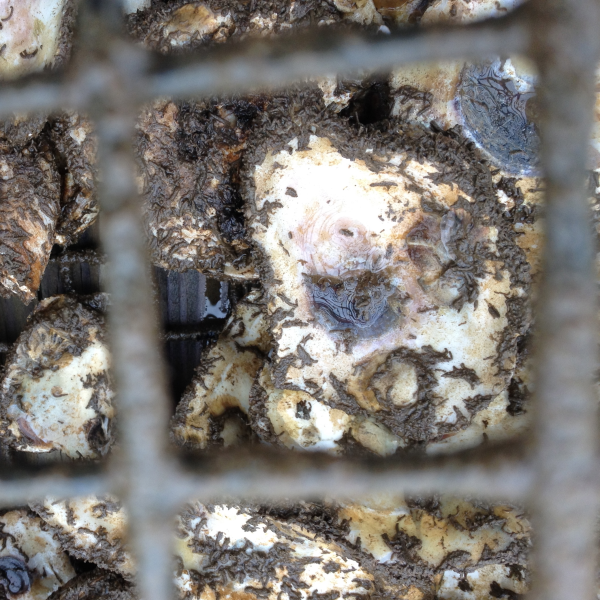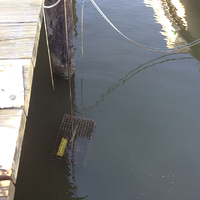Posted by Megan Shitama Weston ● Tue, Oct 29, 2013 @ 15:10 PM
Meet Our Oyster Babies
 You might have noticed the pictures we have posted of our “oyster babies” in the last month - this winter we are fostering cages of oyster spat! A couple weeks ago we invited our SOWI campers to join us in checking in on them. They rolled up their sleeves and got their hands (and in some cases shirts, pants, feet, etc) dirty, in order to practice hands-on creation care.
You might have noticed the pictures we have posted of our “oyster babies” in the last month - this winter we are fostering cages of oyster spat! A couple weeks ago we invited our SOWI campers to join us in checking in on them. They rolled up their sleeves and got their hands (and in some cases shirts, pants, feet, etc) dirty, in order to practice hands-on creation care.
Why Oysters?
When John Smith (the real one, not the one voiced by Mel Gibson) first explored the Chesapeake Bay and its rivers he noted that the water was crystal clear, and that he had to navigate his boats around large reefs where oysters “lay thick as stones.”
European settlers never imagined that the great bounty of fish and shellfish in the bay would ever run out, and so they harvested them enthusiastically.
Nowadays, historic over-harvesting, poor bay health, and the parasitic diseases MSX and Dermo have more than decimated the oyster population. It is estimated that the Chesapeake Bay oyster population is about 1% of what it was in the 1800’s.
People living on the Eastern Shore know that the decrease in oysters (and fish & crabs) has made for tough times in communities whose rich heritage and livelihood are rooted in a thriving seafood industry. In the 1800’s there were still billions of oysters in the bay, and watermen were harvesting 25 million bushels annually. In recent years the harvest was around 200,000 bushels a year.
This summer, someone at the Chester River Association suggested that Pecometh might want to take part in the Marylanders Grow Oysters program. We would “adopt” four cages of “spat on shell” - baby (larval) oysters attached to recycled oyster shells.
We jumped at the opportunity! It sounded like a fun project for us - one that we can share guests, school groups and our SOWI campers.
 We’re Not Sure What We’re Looking At Exactly... Yet
We’re Not Sure What We’re Looking At Exactly... Yet
In September, our oyster babies arrived, and we carefully hung them off the pier.
They have to be hung so that they are completely submerged at all times, but don’t touch the bottom of the river where sediment could smother them. (Increased sediment - like dirt that washes into the rivers - is another reason that the oysters are in trouble.)
Earlier this month, we brought some of our SOWI campers down to the river to check out the progress and help care for the cages. We pulled up the cages and set them on the pier for awhile, but there isn’t a whole lot to see yet - the oysters are still too small. In fact, oysters only grow about an inch a year! That means that a typical oyster you see in a restaurant is 3-4 years old.
Our oysters will only be about the size of quarters by the time they are picked up in late spring. They will be planted on an oyster sanctuary where they will be able to thrive. These protected oyster reefs help to improve water quality, and create a safe habitat for other aquatic creatures.
Even though the oysters are still tiny, we let the kids look at and carefully touch the shells as we talked about why oysters are important.
They also used brushes to help clean some of the muck off of the cages, since too much gunk on the cages can prevent fresh water from flowing into the cages.
Since many of these kids will return for future SOWI days, they will be able to come back and see progress through-out the year.
From Crystal Clear to Chester Funk
These days the Chesapeake Bay water is not so crystal clear, and neither is the Chester River. Summer staff have a term for that murky brown quality that the river sometimes has... we call it the Chester Funk.
The water is murky for a variety of reasons, but a thriving oyster population could help with this.
 Oysters feed on plankton by filtering it out of the water. As we told the campers, a full-grown oyster is like a little living Brita pitcher that can filter up to 50 gallons of water a day!
Oysters feed on plankton by filtering it out of the water. As we told the campers, a full-grown oyster is like a little living Brita pitcher that can filter up to 50 gallons of water a day!
It is thought that back when we had billions of oysters, the oysters could filter the whole Bay in about a week!
When we were done taking care of the cages, the kids did a little experiment in observing turbidity (how cloudy the water is due to particles of dirt and other matter in the water).
Before we lowered the cages back into the water, we had the kids guess how many feet down we could lower the cages before we couldn’t see them anymore. Their guesses were in the ballpark of 10-20 feet... but of course the actual result was around 2 feet. Pretty funky.
There’s Good News
The good news is that projects like Marylanders Grow Oysters seem to be helping to curb oyster decline. If we take steps to improve water quality in the bay and rivers, oysters will fair better, and in turn they will help improve the water quality. Look for future blogs talking about ways that we can improve water quality in our own rivers.
In the meantime our oysters are growing and we’re pretty excited about caring for them.
If you’re ever around at Pecometh we’d love to show them to you, but please don’t pull the cages up unless a staff person is with you. And if you happen to see any non-staff messing with them please let us know.
As much as we want to share this project with others, we are also aware that people may want to “harvest” them for themselves.
We’ll let you know how things are going!
Bibliography and Resources:
National Oceanic and Atmospheric Administration - Oyster Reefs
Oysters Are on the Rebound in the Chesapeake Bay, New York Times
Chesapeake Bay Program - Captain John Smith
Marylanders Grow Oysters Program
Topics: Outdoor Classroom
